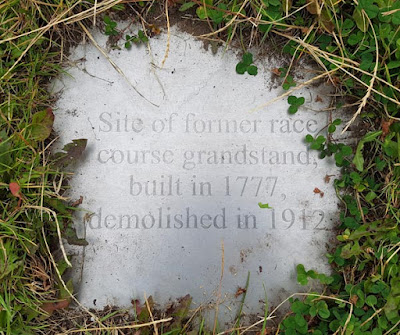 |
| The Forest Recreation Ground |
In terms of its historical interest, though, it is far more compelling.
In the 1840 edition of his book The Rural Life of England, William Howitt described the Forest as '...a long, furzy common, crowned at the top by about twenty windmills, and descending in a steep slope to a fine level, round which the race-course runs.' - a quote that is enshrined in stone on a set of steps near (and to the rear of) the pavilion.
 |
| The Howitt quote on a beautiful set of steps near the pavilion |
The racecourse to which Howitt refers was once an incredible four miles long, extending out towards Radford, though by 1813 it had been reduced in size to a mile and a quarter. The last race meeting was held in September 1890.
One of the features of the racecourse that particularly interested me when I first read about it was the grandstand, which was designed by the architect John Carr (also responsible for grandstands at several other racecourses) and built in 1777.
A local newspaper of the time, reporting on the commencement of the grandstand's construction, was of the opinion that, 'to [the architect], and the subscribers of so noble an edifice, it is not to be doubted, but praise will be handed down to future generations.'
The report went on to provide a full description of the facility:
'The above building will extend upwards of 81 feet in the front, and in the centre upwards of 52 feet wide; the lower story will consist of tea and card rooms, a vestibule, and geometrical staircase, exclusive of a kitchen, bar, store rooms, cellars, &c.; and the upper story of a genteel room, upwards of 61 feet long (breadth in proportion); this room is designed, not only for entertainments, but so ordered that those ladies and gentlemen who don't choose to stand on the veranda or platform (which is to be supported by an arcade below), may have an opportunity of seeing the course in every part. The roof will have steps thereon, covered with lead, on which near 500 people may stand at once, and will, as well as the veranda or platform below, be inclosed with a stone balustrade.'
John Blackner, in his History of Nottingham (1815), described the structure as 'handsome'. Robert Mellors, on the other hand, in his book The Gardens, Parks and Walks of Nottingham and District (1926), deemed it to have been been 'an exceedingly ugly building...'
 |
| The grandstand in 1900 |
By the early 1900s, the Public Parks Committee was recommending that the grandstand, which by that point was said to be in a dilapidated state, having been largely unused for some time, should be demolished. The committee's wish was granted, and by 1912 it had vanished for good.
By using online mapping facilities, I was able to work out exactly where the grandstand had been located, and I decided to have a stroll down to the Forest to inspect the area in question.
 |
| Detail from an old OS map |
 |
| Aerial image showing the former location of the racecourse grandstand (the blue rectangle), determined by using Insight Mapping and the National Library of Scotland's side by side georeferenced map viewer |
In the event, as I explored the former footprint of the grandstand, to the east of the park and ride site, I saw neither. What I did discover, to my great surprise, was a plaque in the ground that read, 'Site of former race course grandstand, built in 1777, demolished in 1912'.
 |
| Plaque on the site of the former Forest racecourse grandstand |
 |
| View towards the Forest Park & Ride site, with the grandstand plaque in the foreground |
The plaque seems to be of fairly recent vintage and is in remarkably good condition given that it has to survive the depredations of Goose Fair every year. I've been unable to find any mention of it online, so its origins will have to remain a mystery for now.
In a world that sometimes seems to have less respect for the past than ever before, it is just nice to know that it is there.
No comments:
Post a Comment